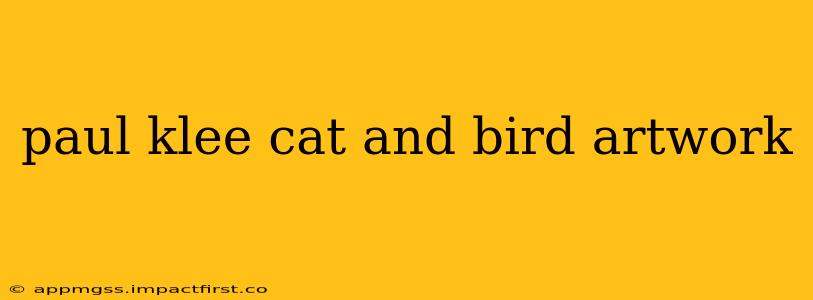Paul Klee, a titan of 20th-century art, wasn't just a painter; he was a storyteller, a poet, and a whimsical observer of the world around him. His works, often characterized by vibrant colors, simplified forms, and a childlike sense of wonder, invite viewers to engage with their inherent narratives. Among his diverse body of work, his depictions of animals, particularly cats and birds, hold a unique charm and offer fascinating insights into his artistic process and philosophy. This exploration delves into Klee's captivating portrayals of cats and birds, examining their symbolism, artistic techniques, and lasting impact.
What are some of Paul Klee's most famous cat and bird paintings?
While Klee didn't dedicate a large portion of his oeuvre to solely cat and bird subjects, these creatures frequently appear in his works, often integrated into broader compositions. Pinpointing definitive "most famous" paintings is subjective, depending on individual preferences and interpretations. However, many of his works featuring animals stand out for their unique blend of abstraction and realism. Many examples exist in various collections worldwide and aren't consistently available for public online viewing, thus hindering a definitive list. Searching Klee's catalog online using keywords like "cat," "bird," "animal," or even exploring collections by date or theme will uncover numerous examples. The specific titles and prominence vary, however, based on the individual collector or museum.
What techniques did Paul Klee use in his cat and bird paintings?
Klee’s mastery lies in his ability to blend seemingly disparate techniques. His works featuring cats and birds often showcase:
-
Simplified forms and lines: He frequently used basic shapes to represent animals, emphasizing their essence rather than photorealistic detail. A few simple lines could evoke the elegant form of a cat or the graceful flight of a bird.
-
Vibrant color palettes: Klee's use of color was highly expressive. He often employed unexpected color combinations to convey mood and emotion, giving his animal subjects an almost ethereal quality.
-
Texture and layering: His works often exhibit a layered effect, suggesting depth and movement. He might use various painting techniques, such as washes or impasto, to create a sense of texture, further enriching the visual experience.
-
Symbolism and narrative: Klee's paintings rarely present animals simply as realistic depictions. He imbued them with symbolic meaning, often reflecting his personal philosophy and exploration of nature's mysteries. A bird in flight could represent freedom, while a cat might symbolize observation or mystery.
What is the symbolism of cats and birds in Paul Klee's artwork?
The symbolism within Klee’s animal depictions is open to interpretation, reflecting both his personal experiences and broader artistic trends. However, some general observations can be made:
-
Birds: Often symbolize freedom, flight, spirituality, and connection to the divine. Their aerial grace could represent the artist's pursuit of creative expression and the boundless nature of imagination.
-
Cats: In Klee's paintings, cats often possess an air of mystery, independence, and quiet observation. They could represent the artist’s introspective nature or his careful observation of the world.
It's crucial to note that Klee's symbolism is rarely explicit; he invites viewers to engage with the work and form their own interpretations.
How did Paul Klee's personal experiences influence his depictions of cats and birds?
Klee's life experiences inevitably shaped his artistic vision. While specific biographical links to individual cat or bird paintings are often unavailable, it's safe to say his experiences with nature, his travels, and his inner life informed his artistic choices. His engagement with natural forms, alongside his spiritual and philosophical inclinations, created a uniquely personal approach to his animal subjects. His travels across diverse landscapes may have contributed to the unique rendering of his animal forms and colours.
Are there any specific artworks you can highlight that feature cats or birds?
Again, pinpointing specific artworks readily available for public viewing online is difficult. Many works are held in private collections or museums that may not have high-resolution images online. However, thoroughly searching online using image search with terms like "Paul Klee cat," "Paul Klee bird," or "Paul Klee animals" will lead you to many examples. Studying these diverse examples showcases the range of his artistic approach to animal subjects and highlights the subtle variations in style and technique over time. Remember to check the specific museum or gallery websites for the most accurate information on the titles and details of any artwork you find.
By exploring the diverse examples of Paul Klee's animal depictions, you can deeply appreciate the artist’s unique creative vision, his technical brilliance, and his ability to transform the familiar into the extraordinary. The mystery and symbolism inherent in his works ensure that their appeal persists, inviting continuous engagement and interpretation.
